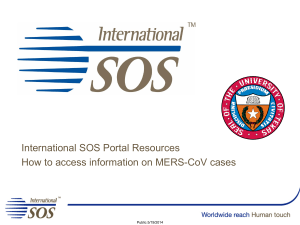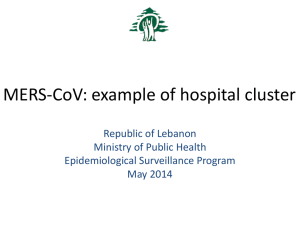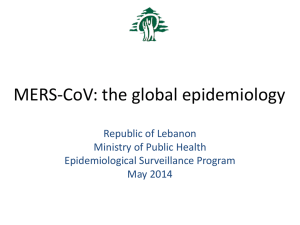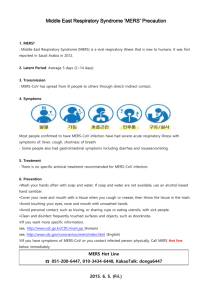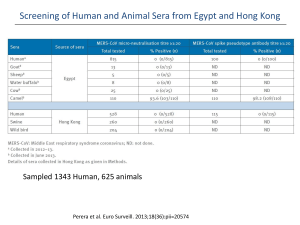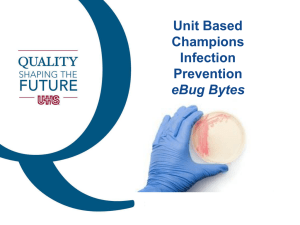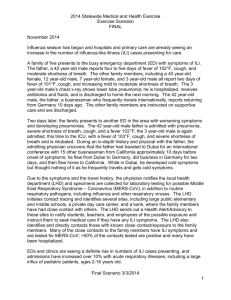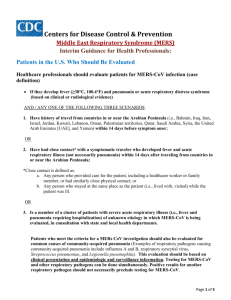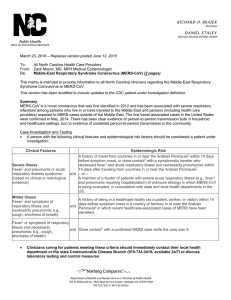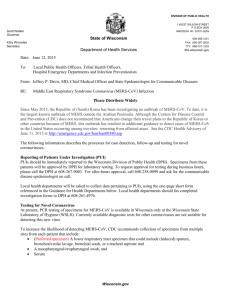Middle East respiratory syndrome coronavirus (MERS-CoV) summary
advertisement
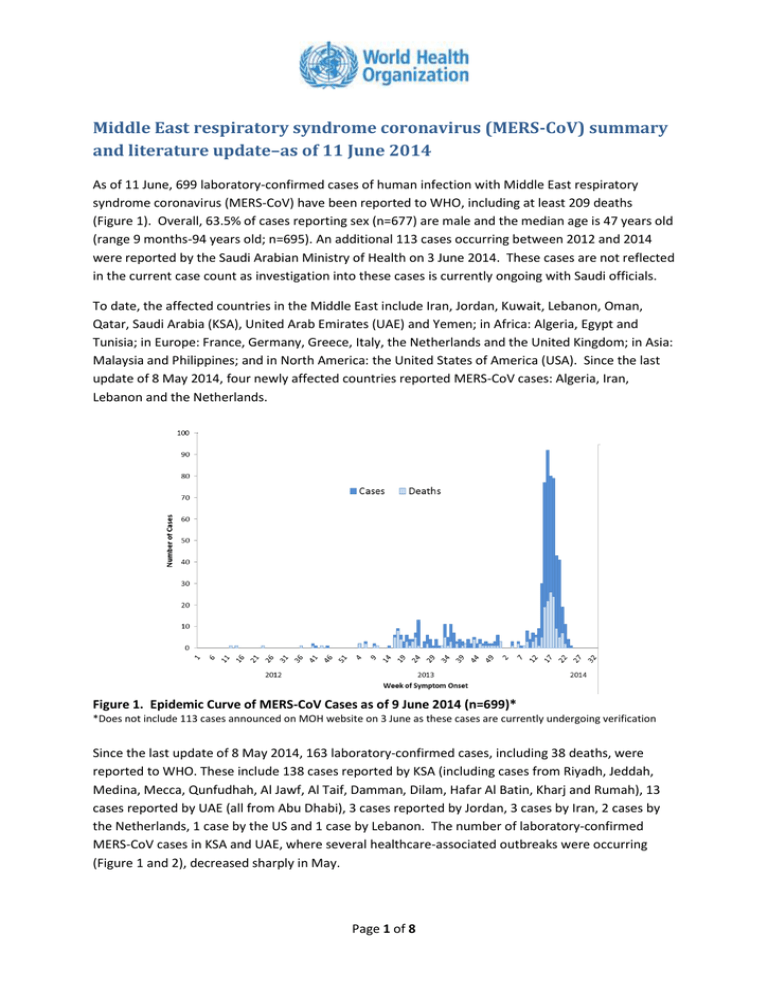
Middle East respiratory syndrome coronavirus (MERS-CoV) summary and literature update–as of 11 June 2014 As of 11 June, 699 laboratory-confirmed cases of human infection with Middle East respiratory syndrome coronavirus (MERS-CoV) have been reported to WHO, including at least 209 deaths (Figure 1). Overall, 63.5% of cases reporting sex (n=677) are male and the median age is 47 years old (range 9 months-94 years old; n=695). An additional 113 cases occurring between 2012 and 2014 were reported by the Saudi Arabian Ministry of Health on 3 June 2014. These cases are not reflected in the current case count as investigation into these cases is currently ongoing with Saudi officials. To date, the affected countries in the Middle East include Iran, Jordan, Kuwait, Lebanon, Oman, Qatar, Saudi Arabia (KSA), United Arab Emirates (UAE) and Yemen; in Africa: Algeria, Egypt and Tunisia; in Europe: France, Germany, Greece, Italy, the Netherlands and the United Kingdom; in Asia: Malaysia and Philippines; and in North America: the United States of America (USA). Since the last update of 8 May 2014, four newly affected countries reported MERS-CoV cases: Algeria, Iran, Lebanon and the Netherlands. Figure 1. Epidemic Curve of MERS-CoV Cases as of 9 June 2014 (n=699)* *Does not include 113 cases announced on MOH website on 3 June as these cases are currently undergoing verification Since the last update of 8 May 2014, 163 laboratory-confirmed cases, including 38 deaths, were reported to WHO. These include 138 cases reported by KSA (including cases from Riyadh, Jeddah, Medina, Mecca, Qunfudhah, Al Jawf, Al Taif, Damman, Dilam, Hafar Al Batin, Kharj and Rumah), 13 cases reported by UAE (all from Abu Dhabi), 3 cases reported by Jordan, 3 cases by Iran, 2 cases by the Netherlands, 1 case by the US and 1 case by Lebanon. The number of laboratory-confirmed MERS-CoV cases in KSA and UAE, where several healthcare‐associated outbreaks were occurring (Figure 1 and 2), decreased sharply in May. Page 1 of 8 Summary of KSA Cases reported between 11 April and 9 June This summary covers cases reported form KSA between 11 April and 9 June, including 138 cases of reported to WHO by KSA since the last update on 8 May. In total, between 11 April and 9 June 2014, 402 laboratory-confirmed cases of MERS-CoV, including at least 114 deaths, from KSA were officially reported to WHO (Figure 2). All of these cases are currently reflected in the WHO case count. Thirty-five cases were reported from Madina, 132 from Riyadh, 208 from Mecca Province (including 154 from Jeddah, 39 from Mecca, 8 from Qunfudhah and 7 from Al Taif), 10 from Tabuk, 6 from Al Jawf, 3 from Najran, and 3 from Ash Sharqiyah (5 cases did not have their location within KSA specified). The nationality of cases was provided for 223 of the 402 cases. Among these 138 were Saudi nationals. The median age of the 402 cases is 46.0 years old (range 9 months-94 years old) and 58.3% of those with information on sex (n=388) are male. Almost half (44.5%) of the cases with reported information (n=398) experienced severe disease including 114 cases who died; 114 cases (28.6%) were reported to be asymptomatic or have mild disease. Of 149 cases for which information was provided, 140 reported to have at least one underlying medical condition. More than 25% of the reported cases are health care workers (109/402). Among the 109 health care workers, 63 were reported as asymptomatic or developing mild symptoms, 35 with moderate symptoms (requiring hospitalization but not admission to an intensive care unit), 7 were reported as having severe disease and 4 were fatal. Figure 2. Epidemic Curve of Cases reported by KSA by outcome Newly affected countries: Algeria, Iran, Lebanon and the Netherlands Algeria has reported its first laboratory-confirmed cases on 1 June 2014. Both cases had separately travelled to Saudi Arabia for pilgrimage in May and sought treatment upon returning to Algeria. It is unknown whether these two cases had contact with a known MERS-CoV case, visited a health care health care facility or had contact with animals while in KSA. Investigations among contacts of the two cases while in Saudi Arabia and in Algeria are currently ongoing. Page 2 of 8 Iran reported its first laboratory-confirmed MERS-CoV cases on 26 May 2014. The first two cases were sisters who had no history of travel, or contact with camels, but who had close contact with an individual with influenza-like-symptoms who had recently travelled to KSA to perform Umrah. Investigations are currently ongoing in Iran to determine if the close contact has been tested for MERS-CoV. One additional case, a 35 year old female health care worker caring for the first reported Iran case, was identified on 4 June. Lebanon reported its first case on 8 May 2014 in a health care worker who no reported contact with a known MERS-CoV case, had not travelled to the Middle East within the 14 days prior to symptom onset and did not have contact with animals or animal products. The patient is known to travel to several countries in the Gulf region, but his most recent travel was five weeks prior to symptom onset. Investigations are ongoing in the source of his infection. The Netherlands reported two MERS-CoV cases 1 among siblings who travelled to Medina and Mecca KSA between 26 April and 10 May 2014. Investigations are ongoing to identify the source of exposure, however it is known that the male patient, 70 years-old, visited medical care facilities in Medina or Mecca while in KSA. The sister, 73 years-old, was identified as a case through contact tracing investigation. Both cases had underlying conditions that have been shown to pre dispose to severe disease.2 A total of 78 close contacts (among which were the travel group, relatives and flight contacts) were monitored for a period of 14 days, and no additional cases of MERS-CoV infection were identified during this period. Follow up of contacts of exported cases in April-June 2014 has continued since the last summary. No additional cases have been identified in Algeria, Egypt, Greece, Lebanon, Malaysia, the Philippines or the USA from the recent exported cases to those countries. However, Jordan reported further transmission from a case exported from KSA. Limited human-to-human transmission was reported in Iran in a health care worker caring for one of the exported cases. WHO MERS-CoV related activities and upcoming guidance A WHO Global Outbreak Alert and Response Network (GOARN )mission is ongoing in KSA to work with the Ministry of Health, and provide technical advice for the national response, to support field investigations for MERS and to support international coordination of external experts supporting the Ministry for MERS. Several human and animal investigations are currently underway to better understand MERS-CoV in animal populations and their environments, risk factors for human infection in health care settings and detailed review of MERS-CoV case histories is on-going. A WHO team with experts from GOARN technical partners concluded a 5 day mission in UAE on 6 June to follow-up on the Al Ain outbreak, and recent cases. Six experts were deployed in coordination, epidemiology, infection prevention and control, food safety and the human-animal interface, and risk communication. The team had extensive discussion with Health Authority Abu 1 http://www.eurosurveillance.org/ViewArticle.aspx?ArticleId=20817 2 http://www.ncbi.nlm.nih.gov/pubmed/23891402) Page 3 of 8 Dhabi, Dubai Health Authority and the Abu Dhabi Food Control Authority, and visited the hospital in Al Ain. They concluded that the recent upsurge of cases in Abu Dhabi was caused by a combination of factors, including a breach in infection prevention and control measures in health care settings, active surveillance and increase in community acquired cases. More information can be found here: http://www.who.int/features/2014/mers-cov-riskassessment/en/ A WHO mission to Qatar, 17-22 May, 2014 reviewed infection prevention and control (IPC) guidelines/plans at different levels, and available IPC measures currently implemented in health care facilities in Qatar. A technical mission was conducted in Lebanon from 26 to 30 May to assess the situation with regards to strengthening SARI surveillance for early detection of suspected MERS-CoV cases during the Umrah and Hajj. WHO published updated travel advice on MERS-CoV for Pilgrimages on 3 June 2014, which is available at: http://www.who.int/ith/updates/20140603/en/ WHO convened a meeting of laboratory experts from 10-12 June in Lyon, France, to finalize updated recommendations on laboratory testing for MERS-CoV. The recommendations will take into account the latest information on serological testing which will become more important as the number of asymptomatic and mildly ill cases increases. The WHO Regional Office for the Eastern Mediterranean (EMRO) organized a sub-regional workshop in Riyadh, KSA from 1-3 June on improving infection prevention and control measures in health facilities for acute respiratory infection and specifically for MERS-CoV. IPC professionals from KSA, Kuwait, Lebanon, Egypt, Oman, Tunisia, Libya, Morocco, Bahrain, Jordan and Pakistan attended this workshop. At the end of the workshop, a framework was developed for improving health facilities preparedness for MERS focussing on strengthening IPC measures in healthcare settings. WHO conducted a consultation to update the MERS-CoV surveillance recommendations and case definitions. WHO with the Global Infection Prevention and Control Network and other IPC experts has reviewed interim IPC recommendations to expand guidance on the management of asymptomatic PCR-positive cases and on the duration of additional precautions for hospitalized patients with MERS-CoV infection. Selected MERS-CoV Literature A detailed summary of the two MERS-CoV cases reported by the Netherlands recently provided information of the cases’ travel history, clinical presentation and medical care history in KSA and the Netherlands. All contacts, including those traveling with the two cases to KSA, family members and health care worker contact in the Netherlands, were followed and tested negative Page 4 of 8 for MERS-CoV. The source of infection is currently unknown but infection could have been acquired while visiting a health care facility while in KSA. Source: Kraaij-Dirkzwager Me et al Middle East respiratory syndrome coronavirus (MERS-CoV) infections in two returning travellers in the Netherlands, May 2014. Euro Surveill. 2014 May 29;19(21). pii: 20817. Available at: http://www.eurosurveillance.org/ViewArticle.aspx?ArticleId=20817 A prospective study of two dromedary herds in Al Hasa, KSA collected samples from the herds between November 2013 and February 2014. The researchers from KSA and Hong Kong found MERS-CoV virus in both nasal and fecal samples. Full genome sequences of MERS-CoV from dromedaries in this study were 99.9% similar to genomes of human clade B MERS-CoV. The viruses were most closely related to viruses detected in Buraidah, KSA, Al Hasa KSA and the MERS-CoV_FRA/UAE virus. Pre-existing neutralizing antibodies did not appear to protect against infection in camels. Source: Hemida et al MERS coronavirus in dromedary camel herd, Saudi Arabia. Emerging Infect Dis. 2014 Jul Available at: http://dx.doi.org/10.3201/eid2007.140571 Preliminary results from an ongoing investigation in Qatar were shared with WHO and announced in a press release by the Supreme Council of Health in Qatar. Their results show that people working closely with camels (e.g. farm workers, slaughterhouse workers and veterinarians) may be at higher risk of MERS-CoV infection than people who do not have regular close contacts with camels. In Qatar and several other countries, animals, including goats, cows, sheep, water buffalo, swine and wild birds, have been tested for antibodies to MERS-CoV, with no positive results. The absence of antibodies in these animals indicates that the likelihood of other animals having a substantial role in transmission of MERS-CoV is very low. These studies provide evidence that camels are a likely primary source of the MERS-CoV that is infecting humans. Summary and Risk Assessment This risk assessment is based on currently available data and knowledge, and will be updated as more information is made available. The investigations are still ongoing and new findings on, for example, exposures to animal and/or environmental source, transmission chains, risk factors for infection among primary cases and healthcare workers, and serological investigations will be critical to make the risk assessment more robust. WHO is continuing to work with the Ministries of Health in Saudi Arabia, UAE and other affected countries and international partners to better understand the reasons for the increase in cases reported since March 2014. The WHO missions to KSA and UAE found that the upsurge in cases both countries were explained by several hospital-related outbreaks that resulted from a lack of systematic implementation of infection prevention and control measures. Since mid-May, the numbers of cases in KSA and UAE have sharply declined. Page 5 of 8 Has the transmission pattern of MERS-CoV changed? Further investigation and review of MERS-CoV cases recently reported by KSA has revealed that the vast majority of the cases initially classified as “primary” cases (i.e., cases with no links other confirmed cases), had in fact contact with another confirmed MERS-CoV case, or had been to a health care setting in which there were MERS-CoV cases treated within the previous 14 days prior to symptom onset. Therefore, most of the cases recently reported from KSA reflect infection acquired through human-to-human transmission in health care settings. The large outbreaks in Jeddah and Riyadh, and the reports of smaller hospital-associated cases in other parts of the country, emphasise the importance of infection control strategies and practices, not only when caring for suspected MERS-CoV patients, but also when caring for patients in all circumstances. Investigations in KSA and UAE are ongoing to evaluate the role of asymptomatic PCR-positive cases in human-to-human transmission and ensure all other potential sources of transmission have been ruled out. It should be mentioned that a number of the recently reported asymptomatic cases, have subsequently developed mild symptoms. Until more is known about MERS-CoV, close monitoring and investigation of all contacts of laboratory confirmed cases, including asymptomatic contacts, should be conducted. Based on available information from recent cases in KSA, UAE and from all recently affected countries, there is no evidence of sustained human-to-human transmission in the community. Therefore, the overall transmission patterns previously observed remain unchanged. WHO bases this assessment on the evidence that: I. II. III. IV. The clinical picture appears to be similar to what was observed previously; secondary cases tend to present with a more mild disease than primary cases; many of the recently reported secondary cases have had mild symptoms, or were asymptomatic; The recently exported cases have not resulted in sustained onward transmission (contact tracing is still ongoing); Intensive screening of MERS-CoV contacts revealed very few instances of household transmission; and There has been no increase in the size or number of observed household clusters. Can we expect additional cases of MERS‐CoV infection in the Middle‐East countries and exported cases to other countries? WHO expects that additional cases of MERS-CoV infection will be reported from the Middle East, and that it is likely that cases will continue to be exported to other countries by tourists, travellers, guest workers or pilgrims who might acquire infection following exposure to an animal (for example, while visiting farms or markets) or human source (possibly in a health care setting). Until more is understood about mode of transmission and risk factors for infection, cases resulting from zoonotic transmission will continue to occur, and will eventually lead to limited community transmission within household and possibly significant hospital-associated outbreaks. Among the recently Page 6 of 8 exported cases who reported to have performed Umrah in KSA, investigation into their activities while in KSA have revealed that most have either visited a health care facility or had come in contact with camels or raw camel products while in KSA. Urgent epidemiologic investigations are required to better understand the transmission patterns of this virus. The most urgent needs include understanding how humans become infected from animal or environmental source(s) through case-control studies, identifying risk factors for infection in health care settings, and enhancing community studies and surveillance for community-acquired pneumonia. Collaboration between human and animal health sectors is essential to understand the risk of transmission between animals and humans. WHO understands that detailed epidemiologic investigations are underway in Qatar, KSA and UAE. WHO guidelines and tools on investigations can be found here: WHO guidelines for investigation of cases of human infection with Middle East Respiratory Syndrome Coronavirus (MERS-CoV) pdf, 359kb Middle East Respiratory Syndrome Coronavirus (MERS-CoV) Initial Interview Questionnaire of Cases pdf, 114kb Case-control study to assess potential risk factors related to human illness caused by Middle East Respiratory Syndrome Coronavirus (MERS-CoV) pdf, 257kb Seroepidemiological Investigation of Contacts of Middle East Respiratory Syndrome Coronavirus (MERS-CoV) Patients Recommendations Enhancing infection prevention and control awareness and implementation measures is critical to prevent the possible spread of MERS-CoV in health care facilities. It is not always possible to identify patients with MERS-CoV early because some have mild or unusual symptoms. For this reason, it is important that health care workers apply standard precautions consistently with all patients, regardless of their diagnosis, in all work practices, all of the time. Droplet precautions should be added to the standard precautions when providing care to any patient with symptoms of acute respiratory infection. Health care facilities that provide care for patients suspected or confirmed to be infected with MERS-CoV infection should take appropriate measures to decrease the risk of transmission of the virus from an infected patient to other patients, health care workers and visitors. Contact precautions and eye protection should be added when caring for probable or confirmed cases of MERS-CoV infection, and airborne precautions should be applied when performing aerosolgenerating procedures. Until more is understood about MERS, people at high risk of developing severe disease (those with diabetes, renal failure, chronic lung disease, and immunocompromised persons), should take Page 7 of 8 precautions when visiting farms and markets where camels are present. These precautions include: avoiding contact with camels; not drinking raw camel milk or camel urine; and not eating meat that has not been thoroughly cooked. Preliminary results from recent studies in Qatar indicate that people handling or working with camels are at increased risk of infection with MERS-CoV compared with people who do not have contact with camels. Until more evidence is gathered, it is prudent for camel farm workers, slaughterhouse workers, market workers, veterinarians and those handling camels at racing facilities to practice good personal hygiene, including frequent hand washing after touching animals. They should wear facial protection where feasible and wear protective clothing. These workers should also avoid exposing family members to soiled work clothing, shoes, or other items that may have come into contact with camel excretions. It is therefore recommended that these clothes and items remain at the workplace for daily washing and that workers have access to and use shower facilities at their workplaces before leaving the premises. Camels infected with MERS-CoV may not show any signs of infection. It is therefore not possible to know whether an animal in a farm, market, race track or slaughterhouse is excreting MERS-CoV that can potentially infect humans. However, infected animals may shed MERS-CoV through nasal and eye discharge, faeces, and potentially in their milk and urine. The virus may also be found in the organs and meat of an infected animal. Therefore, until more is known about infection in animals, the best protection is to practice good hygiene and avoid direct contact with all of these. Obviously sick animals should never be slaughtered for consumption; dead animals should be safely buried or destroyed. Unless protected, people should avoid contact with any animal that has been confirmed positive for MERS-CoV until subsequent tests have confirmed that the animal is free of the virus. Countries outside the affected region should maintain a high level of vigilance, especially those with large numbers of travellers or guest workers returning from the Middle East. Surveillance should continue to be enhanced in these countries according to WHO guidelines, along with infection prevention and control procedures in health care facilities. WHO continues to request that Member States report all confirmed and probable cases along with information about their exposures, testing, and clinical course to inform the most effective international preparedness and response. WHO does not advise special screening at points of entry with regard to this event nor does it currently recommend the application of any travel or trade restrictions. Page 8 of 8
